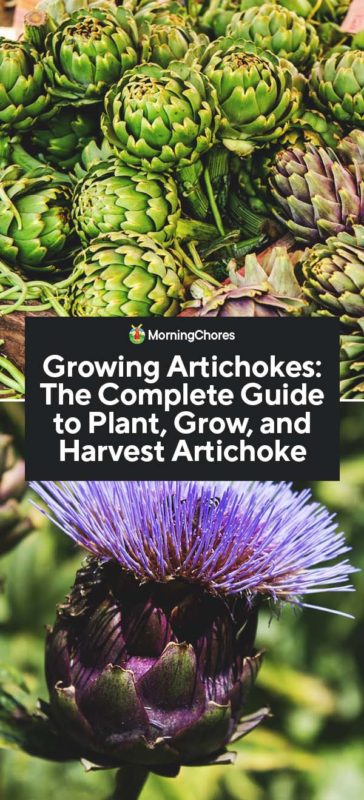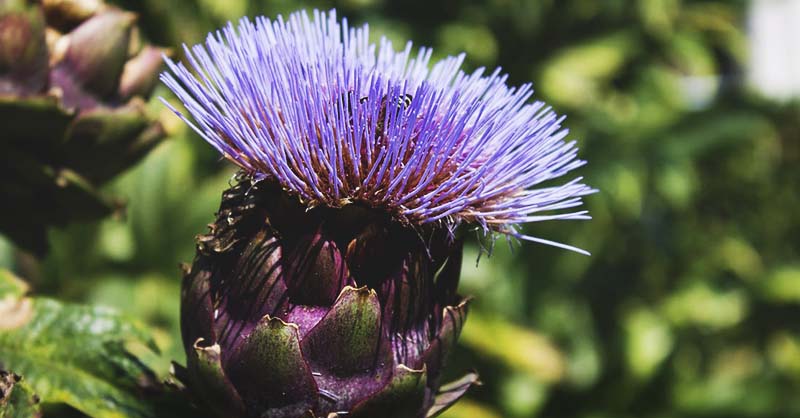If they had the opportunity to taste this vegetable in its most fresh form, I believe more individuals would be cultivating artichokes. Those who claim to despise artichoke are often referring to the canned variety. The preserved product does not have the same amazing flavor of fresh artichoke from the garden, despite being edible.
Because it’s difficult to come by or isn’t always in the greatest shape, fresh artichoke frequently becomes a uncommon treat. It’s usually expensive, even if you can find it in season and in good condition. Yet, I can never seem to get enough of that rich center, which has a nutty asparagus-celery flavor.
Artichokes are a lovely decorative addition to the garden, even if you aren’t a lover of the vegetable itself. A closed bud of a flower is what you eat when you dine on an artichoke. Adding this exotic plant to your edible landscaping mix is a bit unusual. In certain climates, artichokes are perennial, and I love plants that come back each year.
Unfortunately, due to the harsh winters in my area, I am only able to grow them as an annual. Artichokes, on the other hand, are a delectable and sophisticated treat for the home grower whether you grow them yearly or perennial. You can snack on these delicious veggies straight out of the garden with our guide, which includes suggestions for planting, a list of ideal varieties to try, upkeep advice, and more.

Artichoke Varieties

Which artichoke variety should you try? Here are some ways to cultivate this delicious plant in your garden.
- For those in less than ideal growing conditions for artichokes, Tavor (aka Imperial Star) is the perfect variety. In the first year after planting, it produces the edible bloom part, allowing it to develop and be consumed without an overwintering period. The artichokes have a buttery, delicate flavor, and the plant itself is nearly spineless. It takes 90 days to mature.
- This huge plant, which can tolerate part shade, grows to be 4 feet tall and broad. Second-year buds from this plant are best in warmer climates, and they are ideal. Each year, more buds develop. In zones 8-11, it’s a perennial.
- Wonder is a non-spined artichoke cultivar that produces large, early harvests. The core of the pear-shaped heads is solid and flavoursome.
- Artichoke Romagna Purple is a purple-tinged artichoke variety best suited for warm areas. It’s more delicate than a regular green globe.
- An heirloom artichoke cultivar with a purple color known as Violet de Provence. It has a pleasant flavor and is pleasing to the eye.
- Red and green tapered leaves characterize Chianti, a big, rich variety. It’s less bitter than others, for example.
- The artichoke of Omaha can grow to be 6 inches in diameter and have a spherical shape. It isn’t as bitter as some others, and it has a rich, meaty consistency.
- Fiesole is a wine-colored plant with a delicate stalk and a fruity flavor. It comes in a tiny form that is practically fully edible.
- Cardoons are a tougher cousin of the artichoke plant. The stem rather than the flower bud is consumed, making it resemble a thistle more than an artichoke. To create the greatest flavor, they must be blanched while growing.

Planting Artichoke
Temperature Requirements
Climate is critical when growing artichokes, and the first thing you should understand is that. For success with this gourmet treat, you must choose your variety wisely. The plant is not particularly suited for colder locations since it is a perennial.
In colder climates, you’ll need to choose a cultivar that has been developed to be cultivated as an annual and start it indoors in late winter. Otherwise, you will get very little produce.
This plant can grow for many years in warm climates. Zone 10 to 11 is the optimum environment for a perennial blooming plant. Artichokes may be overwintered down to zone 8 for some people. While some may have had success in zones 5 and 6, it is an annual in zone 7.
Starting Artichoke
This plant may be started from seed indoors. Seeds should be started at least eight weeks before the last frost, as a perennial. Begin 100 days before the first frost date in the autumn. You may need to start seeds as early as late January if you’re cultivating it as an annual.
I recommend growing artichokes using dormant roots from a nursery if you’re a beginner. With this moderately challenging plant, there’s one less setback to worry about.
Planting shoots from an established plant of a friend or family member is another way to start growing artichokes. To start artichokes in your garden, you may also order or purchase roots from seed firms.
Seed Germination and Transplanting
Plant seeds an inch deep in one-quarter-inch holes. Seeds take around a week to germinate, however this time may vary depending on circumstances. Seeds should be kept moist, but not soggy.
When the danger of frost has passed, transplant around two weeks following the previous frost date. Harden the plants off for at least 10 days when they are around 8 inches tall and hard.
To signal the plants that they should begin blooming, artichoke seedlings require a chilly period. Exposure to temperatures around 50°F for a couple of weeks will suffice.
Sun and Soil Requirements
Artichoke babies will thrive in full sun. Part shade may be handled by some varieties.
Spacing
Provide artichoke plants some air space when spacing them out. Remember that artichokes grow tall and have a generous spread when they are growing. Around each plant, you’ll need at least 4 feet of space. Since artichokes will die before reaching full size, you can plant them as annuals a little closer together.
Artichokes should be planted in a location that will allow them to grow tall. Your plant might survive for a few years if you are in a warm zone. Decide on where to plant your artichoke. If you prefer, you may also cultivate them in pots, but a huge pot is required.
Caring for Artichoke

Watering
Watering is important, and it should be done often. Your plant will perish from drought and overly wet soil, so it’s crucial to avoid drying out. If the soil is too moist, however, your plant will perish. The key to succeeding with this plant is keeping soil moisture balanced.
Temperature
Artichoke thrives in warm temperatures, but it requires chilling before it will develop, so keep that in mind when growing. If it’s grown as an annual or perennial, the process varies.
Fertilizing
Since growing artichokes are hungry feeders, apply a balanced fertilizer on them every 2 or 3 weeks throughout the growing season. heap compost manure around the plant and apply an organic fertilizer when transplanting or planting.
Pruning
In comparison to plants in colder climates, pruning is more critical for perennially cultivated artichokes. Leaves should be kept in check so they don’t encroach on other plants. Trim the stem to the base after you’ve collected all of the flower buds.
Weeding
To avoid artichoke growth being disturbed and diseases being spread, remove weeds on a 24-hour basis. Weed suppression can be done by mulching.
Artichoke Problems and Solutions
Damping Off
Unless you are taking careful care to clean equipment and supplies, you may get sickly, dead seedlings due to damping off if you plant artichoke seedlings.
Slugs and Snails
Slug troubles are prevalent in humid and moist conditions, and they are a issue for young artichoke plants. To get rid of slugs, use traps to capture them and water selectively to prevent excess moisture and humidity.
Aphids
A variety of leaf sucking insects, such as aphids, are also susceptible to artichoke. Bugs are a nuisance, and they frequently spread diseases. You may not be able to see bugs at a glance because artichoke has plenty of foliage for them to hide in. It is important to examine the leaves carefully.
It isn’t ideal to dislodge the little suckers with a powerful spray of water from a hose since the excess moisture may cause fungal infections. Instead, drop animals in soapy water and pick them off. Another way to get rid of pests on your plants is to use a soap spray.
Cutworms
Artichokes are also a favorite snack of cutworms. During the growing season, keep up on weeding and till your soil in the autumn. Spread diatomaceous earth around your growing artichokes or put cardboard collars on plants.
Artichoke Plume Moth
All of the parts of growing artichokes are eaten by this 1-inch brown moth. Artichokes that are grown as perennials are the primary problem. Parasitic wasps and other beneficial insects may help to eliminate infestations. Remove any infected buds and throw them away.
Painted Lady Butterfly Larvae

While this caterpillar, often known as the thistle caterpillar, may feed on artichoke plants and may be useful in the garden, they are seldom controlled. Look for the spiky black caterpillar with the yellow stripe, pick it off, and deposit it outside your garden.
Botrytis Blight
Infected foliage should be removed to treat Botrytis Blight. Use a fungicide to halt the spread of blight in more severe examples.
Powdery Mildew
Overwatering and watering from above may both lead to Powdery Mildew. The white patches on the leaves are a symptom of the disease. Make sure that all of the water in the morning is for your plants, so they may dry during the day. Rather than relying on rain, the plant gets its water from below.
Companions for Artichoke

Best Companion Plants
Since they provide needed nitrogen for artichoke plants, peas are an excellent companion for this heavy feeder. The two don’t compete for space if you grow the peas behind the tall artichoke stems on a trellis. Pests that may harm developing artichokes should be controlled with sunflower.
- Sunflower
- Tarragon
- Peas
- Violet
- Hollyhock
Worst Companion Plants
Because artichokes are big and spread out, don’t plant anything that requires a lot of room beside them. You may end up crowding out plant artichoke if it gets too close to other veggies. Planting near corn should also be avoided.
Harvesting & Storing Artichoke

Harvesting must take place before the buds on artichoke buds open up into beautiful flowers. When the artichoke buds are still tightly closed, pick them.
If you’re growing artichokes as an annual or perennial, harvesting time varies. Summer is the season for harvesting annual varieties. After two years of planting, perennial artichokes are harvested in the spring.
You can store them in the fridge for roughly a week or two, or you may pickle them if they’re best eaten fresh.

There’s a trick to getting to the meat of this prickly plant if you’ve never tried them before. The underside and base of the artichoke leaves should be peeled back to reveal a delicate eatable portion. It is delicious dipped in butter. The heart of the artichoke, which is the bud’s most delicate and aromatic section, is where the real prize lies.
Artichoke is one of my favorite snacks, whether it’s steamed in butter, roasted in the oven, or baked with cheese. It takes a bit of time to eat, but it is totally worth it.
Are you ready to start planting? We can’t wait to find out how it goes. Tell us what you think in the comments!

